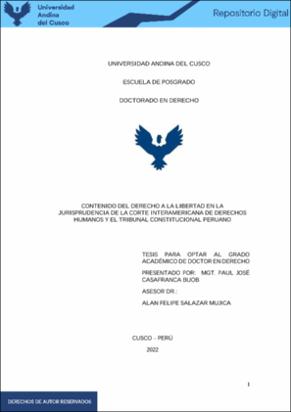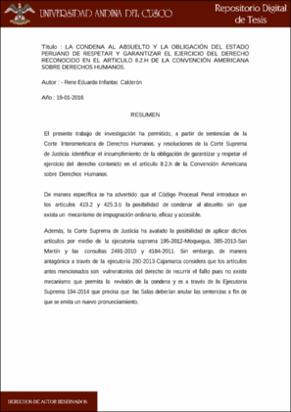| dc.contributor.advisor | Salazar Mujica, Alan Felipe | |
| dc.contributor.author | Casafranca Buob, Paul José | |
| dc.date.accessioned | 2023-01-04T21:02:40Z | |
| dc.date.available | 2023-01-04T21:02:40Z | |
| dc.date.issued | 2022-12-06 | |
| dc.identifier.uri | https://hdl.handle.net/20.500.12557/5139 | |
| dc.description.abstract | El mundo en los últimos tiempos ha sufrido cambios aceleradamente,
trasformaciones que se han dado como consecuencia de una mayor utilización de
la cibernética, lo que ha posibilitado que el mundo esté conectado e informado de
mejor manera, al mismo tiempo, estos cambios trae consigo el reconocimiento de
otros contenidos de un determinado derecho, como el caso del derecho a la
Libertad, que es materia de nuestro estudio, puesto que este derecho hoy por hoy,
no solo comprende el derecho a la Libertad ambulatoria, es decir, de la libertad que
tienen los ciudadanos de desplazarse de un lugar a otro, o el derecho a la libertad
de opinión, el cual comprende la libertad de tener una posición sobre un aspecto
social, económico o político u otro. Actualmente, tenemos que hablar respecto a la
Libertad Sexual, la Libertad Religiosa o la Libertad de Empresa.
Teniendo en consideración ello y lo determinado por la Constitución Política del
Estado y el Código Procesal Constitucional, en los que se establece que los
Derechos Humanos, serán interpretados de conformidad a la Convenciones
Internacionales de Derechos Humanos y lo resuelto por los Organismos
Internacionales de Derechos Humanos, por otro lado, debemos de tomar en cuenta
que el Tribunal Constitucional Peruano, es el máximo intérprete de la Constitución
Política del Estado, teniendo en cuenta ello nuestro trabajo de investigación
aborda el: “CONTENIDO DEL DERECHO A LA LIBERTAD EN LA
JURISPRUDENCIA DE LA CORTE INTERAMERICANA DE DERECHOS
HUMANOS Y EL TRIBUNAL CONSTITUCIONAL PERUANO”.
El objetivo general de nuestra investigación es: Conocer el contenido del Derecho
a la Libertad, teniendo como referencia lo resuelto por la Corte Inter Americana de Derechos Humanos y el Tribunal Constitucional Peruano, es decir, dar a conocer
los alcances, que comprende y que no comprende el derecho de la Libertad
conforme a la jurisprudencia dada por la Corte Inter Americana de Derechos
Humanos y el Tribunal Constitucional Peruano. Por otro lado, son objetivos
específicos de la presente investigación, determinar los alcances y los criterios
racionales y proporcionales para la intervención del Derecho a la Libertad
Ambulatoria, Libertad Religiosa y de Credo, Libertad Sexual, Libertad Cultural y
Libertad de Empresa, a la luz de lo resuelto por la Corte Inter Americana de
Derechos Humanos y el Tribunal Constitucional Peruano.
En la primera parte de la investigación damos cuenta como se concebía en derecho
a la Libertad desde la Edad Antigua hasta la actualidad, de acuerdo a lo cual henos
podido establecer que el derecho a la Libertad, ha estado muy ligado a lo
establecido por la Iglesia, lo cual ha ido superándose paulatinamente hasta hoy, sin
embargo, la intervención de la Iglesia, principalmente de la Católica, aun hoy tiene
injerencia en el reconocimiento de algunas Libertades, principalmente de la
Libertad Sexual.
Luego de ello abordamos el Derecho a la Libertad, en sus diferentes aspectos,
dentro del marco de los diferentes regímenes políticos, igualmente hemos
considerado pertinente estudiar la Estructura, objetivos, competencias y funciones
tanto de la Corte Inter Americana de Derechos Humanos, como del Tribunal
Constitucional Peruano.
Nuestra investigación pone un énfasis en realizar un análisis de la jurisprudencia
emitida por la Corte Inter Americana de Derechos Humanos y el Tribunal Constitucional Peruano, en referencia al contenido y a los límites de intervención
que tienen los Estados, en relación al Derecho a la Libertad Ambulatoria, Libertad
Religiosa y de Credo, Libertad Sexual, Libertad Cultural y Libertad de Empresa | es_PE |
| dc.description.abstract | The world in recent times has undergone rapid changes, transformations that have
occurred as a result of greater use of cybernetics, which has made it possible for the
world to be connected and informed in a better way, at the same time, these changes
bring with them the recognition of other contents of a certain right, such as the case
of the right to Liberty, which is the subject of our study, since this right today, not
only includes the right to ambulatory Liberty, that is, the freedom that citizens have
to move from one place to another, or the right to freedom of opinion, which
includes the freedom to have a position on one social, economic or political aspect
or another. Currently, we have to talk about Sexual Freedom, Religious Freedom
or Business Freedom.
Taking into consideration this and what is determined by the Political Constitution
of the State and the Constitutional Code of Procedure, which establish that Human
Rights will be interpreted in accordance with the International Conventions on
Human Rights and what has been resolved by the International Organizations of
Human Rights , on the other hand, we must take into account that the Peruvian
Constitutional Court is the highest interpreter of the Political Constitution of the
State, taking this into account, our research work addresses the: "CONTENT OF
THE RIGHT TO FREEDOM IN THE JURISPRUDENCE OF THE INTER-
AMERICAN COURT OF HUMAN RIGHTS AND THE PERUVIAN
CONSTITUTIONAL COURT”.
The general objective of our research is: To know the content of the Right to
Liberty, having as a reference what was resolved by the Inter-American Court of
Human Rights and the Peruvian Constitutional Court, that is, to make known the scope, what it understands and what it does not It includes the right of Freedom
according to the jurisprudence given by the Inter-American Court of Human Rights
and the Peruvian Constitutional Court. On the other hand, the specific objectives of
this research are to determine the scope and rational and proportional criteria for
the intervention of the Right to Ambulatory Freedom, Religious and Belief
Freedom, Sexual Freedom, Cultural Freedom and Business Freedom, in the light of
what was resolved by the Inter-American Court of Human Rights and the Peruvian
Constitutional Court.
In the first part of the investigation we realize how the right to Freedom was
conceived from the Ancient Age to the present, according to which we have been
able to establish that the right to Freedom has been closely linked to what was
established by the Church. , which has been gradually overcome until today,
however, the intervention of the Church, mainly the Catholic, even today has
interference in the recognition of some Freedoms, mainly Sexual Freedom.
After that we address the Right to Liberty, in its different aspects, within the
framework of the different political regimes, we have also considered it pertinent
to study the Structure, objectives, competences and functions of both the Inter-
American Court of Human Rights, and the Court Peruvian Constitutional.
Our research puts an emphasis on conducting an analysis of the jurisprudence
issued by the Inter-American Court of Human Rights and the Peruvian
Constitutional Court, in reference to the content and the limits of intervention that
the States have, in relation to the Right to Ambulatory Liberty, Religious and Creed
Freedom, Sexual Freedom, Cultural Freedom and Business Freedom | en_US |
| dc.format | application/pdf | es_PE |
| dc.language.iso | spa | es_PE |
| dc.publisher | Universidad Andina del Cusco | es_PE |
| dc.rights | info:eu-repo/semantics/openAccess | es_PE |
| dc.rights.uri | https://creativecommons.org/licenses/by-nc-nd/4.0/ | es_PE |
| dc.subject | Contenido del derecho | es_PE |
| dc.subject | Derecho a la libertad ambulatoria | es_PE |
| dc.subject | Derecho a la libertad religiosa y de credo | es_PE |
| dc.subject | Derecho a la libertad sexual | es_PE |
| dc.title | Contenido del derecho a la libertad en la jurisprudencia de la Corte Interamericana de Derechos Humanos y el tribunal constitucional peruano | es_PE |
| dc.type | info:eu-repo/semantics/doctoralThesis | es_PE |
| thesis.degree.name | Doctor en Derecho | es_PE |
| thesis.degree.grantor | Universidad Andina del Cusco. Escuela de Posgrado | es_PE |
| thesis.degree.discipline | Derecho | es_PE |
| dc.publisher.country | PE | es_PE |
| dc.subject.ocde | https://purl.org/pe-repo/ocde/ford#5.05.00 | es_PE |
| renati.advisor.dni | 413302 93 | |
| renati.advisor.orcid | https://orcid.org/0000-0002-8005-1275 | es_PE |
| renati.author.dni | 23839206 | |
| renati.discipline | 421018 | es_PE |
| renati.juror | Ríos Mayorga, Julio Trinidad | |
| renati.juror | Diaz Torres, José Hildebrando | |
| renati.juror | Rivero Ynfantas, Fernando | |
| renati.juror | Bravo Melgar, Sidney Alex | |
| renati.level | https://purl.org/pe-repo/renati/level#doctor | es_PE |
| renati.type | https://purl.org/pe-repo/renati/type#tesis | es_PE |





